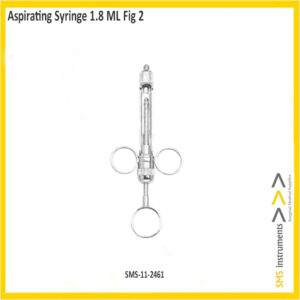Description
Aspirating Syringe
Size:1.2 ml
Dental Instruments
| Surname | Aspirating Syringe |
| Tip Configuration | EU / AM Thread |
| Size / Model / Figure | 1.2 ML |
| curvature | Straight |
| Handle | Ring Finger |
| Finishing | Mirror Polish Finishing |
| Instrument Type | Dental Aspirating Syringes |
| Material | Stainless Steel |
| Disposable or Reusable | Reusable |
| Rusting Prevention | Passivation Processed |
| Cleaning | Ultrasonic Cleaned |
| Sterile or Non-Sterile | Non-Sterile |
| Latex or Latex-Free | Latex-Free |
| Test Performed | Boil, Shape & Performance Test |
| Grade | Premium OR-Grade |
| Packing | Individually Packed in SMS Brand printed Poly-sleeve |
Aspirating Syringes
Dental hypodermic syringe used to inject local anesthetics, especially in dentistry. Before administration of a local anesthetic atthe desired location, the operator applies negative pressure checking for blood in the syringe. This ensures that theanesthetic solution will not be deposited in a blood vessel.
Aspirating Syringes are used in conjunction with a needle and a 1.8 ml prefilled anesthetic cartridge for injection of anesthetic solutions in the oral cavity. Aspirating dental syringe are the standard of care due to their ability to aspirate blood if the tip of the needle is located intravascular. Aspiration system was developed to address the issue of reducing the risk of intravascular injection. The system uses a specific syringe and an adapted cartridge bung with a cavity open at the plunger end. The bungs rely on the elastic nature of a thin membrane at the end of the bung which distorts when pressure is applied. By releasing the pressure, the bung returns to its normal shape, which is sufficient to cause aspiration. As no physical effort is required to cause aspiration, the needle tip is less likely to move, DENTSPLY claims.
This syringe is used in dentistry to inject a local anesthetic. The aspirating syringe differs from most syringes in that it is designed to inject anesthetic from a carpule. The parts of an aspirating syringe consist of a threaded tip where the needle attaches, a barrel where the carpule is placed, a piston rod (plunger) with a harpoon attached that embeds itself into the rubber stopper of the carpule, a finger grip, and a thumb ring. The harpoon allows the dentist to aspirate (draw back) the injection site to see if the needle tip is located in a blood vessel before injecting the anesthetic solution. Once the harpoon is engaged into the rubber stopper of the anesthetic carpule, the dentist can apply inward or outward pressure on the stopper by exerting pressure on the thumb ring. Pulling the thumb ring outward also pulls the plunger outward producing an aspirating effect; whereas, pushing inward forces the anesthetic solution through the needle.
Uses
A common source of adverse reactions in administration of anesthetics is injection into a blood vessel. The dentist can lessen the chance of such an accident by using an aspirating-type syringe, which allows him to check for blood before injection.
Parts
The Dental syringe consists of:
- Syringe barrel
- Finger grip
- Thumb ring
- Piston
- Harpoon
- Needle adapter









